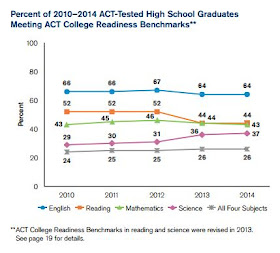Review of Proposed Oklahoma Educational Standards by Barbara McClanahan, Associate Professor of Educational Instruction and Leadership, Southeastern Oklahoma State University.
---------------------------------------
I have finished a cursory review of the PK-4 draft standards, and I don't present my thoughts as based on an in-depth review. I find things I like and things I don't like.
In general, I think the standards for these grades represent an appropriate progression of cognitive skills based on typical child development. I also conferred with a colleague of mine at Southeastern who is more of an early childhood expert than I, and she agrees.
My biggest concern at the PK level, and even K, is a lack of a standard for play. Much recent research suggests strongly that not only is play a critical need for these young students, but pushing the cognitive skills required for early reading may later be found to be detrimental. I think more important than learning letter names or sounds, there should be a standard calling for a substantial portion of the school day to be devoted to both structured and unstructured play. Despite what many people believe, play is a learning strategy and should absolutely have a standard at this level.
My biggest concern at the PK level, and even K, is a lack of a standard for play. Much recent research suggests strongly that not only is play a critical need for these young students, but pushing the cognitive skills required for early reading may later be found to be detrimental. I think more important than learning letter names or sounds, there should be a standard calling for a substantial portion of the school day to be devoted to both structured and unstructured play. Despite what many people believe, play is a learning strategy and should absolutely have a standard at this level.
In addition, all of the standards regarding reading skills, even comprehension of texts read aloud, should be applied very flexibly to allow for a wide range of developmental levels in any given PK-2 classroom.
As we move into K, the content regarding phonics and phonemic awareness builds, but these standards, along with vocabulary, again may not be reachable for a large percentage of students simply because of developmental issues. Again, the standards must be applied flexibly.
Standard 8 for K says: "Students will demonstrate interest in books..." That seems to me to be an impossible standard because interest must be built on students' affect over which the teacher has minimal control. You cannot command students to be interested in books. Recognizing this, I think it is important for the standard to read "Students will demonstrate growing interest in books..." That is something a teacher could monitor through observation and, with reflection, adjust the teaching approach to move the child along on a continuum of interest.
In both PK and K, the word "With guidance and support" appear frequently, but beginning in first grade, they disappear almost completely. Especially for Standard 5, Language, I believe they need to be used to support sentence writing. And again I think the language should read something like "The student will show growth in the ability to compose..." As long as we are determined to maintain and age/grad system, many students will continue to need "guidance and support" into second grade.
Fluency seems inadequately addressed across the board in the standards. In Grade 2, for example, I think there should be something here to the effect that regularly spelled and previously decoded words will be increasingly recognized automatically in order to build fluency. This is the essence of mature reading but is not mentioned anywhere.
In the Grade 2 Writing standard there is a phrase that makes no sense to me: "include past tense or irregularly past tense verbs".
In 3rd Grade, several standards require a level of abstraction that may not be obtainable by a significant percentage of third graders. For example, while according to the standards, third graders need guidance and support to determine the theme of a story, they are expected to negotiate figurative language on their own. Hmmm....
Beginning in the first grade standards, the reading comprehension strategies are essentially the same across the grade levels up through 4th. One must assume that the differences lie in the level of depth to which the student is required to implement them and the level of text, but that is not spelled out. In the standards on Critical Reading and Writing, we see a similar progression of requirements up through the grade levels; I would expect that by 4th grade one of the requirements would be to identify how characters change over the course of the plot, but I did not see it. It could reasonably appear as early as 2nd or 3rd.
One other concern that my colleague had was that there should be a glossary; she fears that not all teachers would understand all the terms being used. Another concern I have is that some of the terms have ambiguous meanings. For example, what does grade-specific or grade-appropriate actually mean?
I actually think this is a pretty good beginning. If I had more time, I would like to compare these with other good standards, such as the "old" Massachusetts ones. Alas, I do not have that kind of time.
I hope this is helpful.




